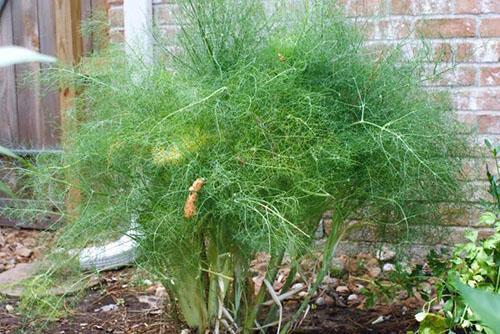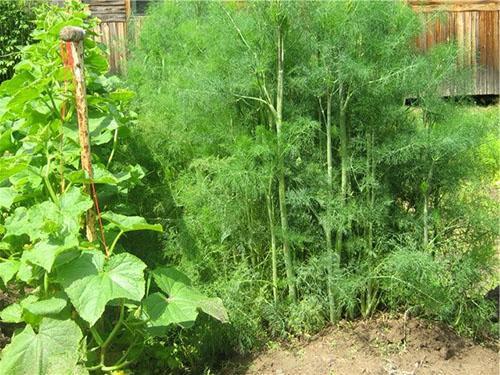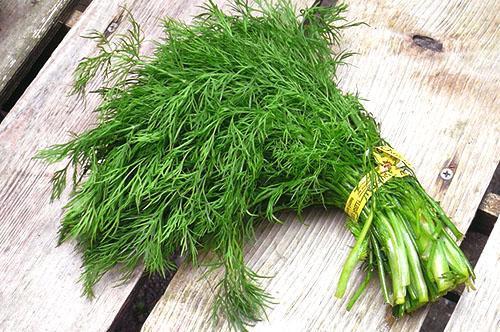How to grow good bush dill?
 Bush dill has not yet become widespread in our country, but has already managed to awaken interest among gardeners. And this is due, first of all, to its high yield. Only 20 bushes can fully satisfy the needs of a family of 3-4 people for this spicy and fragrant greenery.
Bush dill has not yet become widespread in our country, but has already managed to awaken interest among gardeners. And this is due, first of all, to its high yield. Only 20 bushes can fully satisfy the needs of a family of 3-4 people for this spicy and fragrant greenery.

Description of the plant
 There are many varieties of this crop that differ from regular dill unusual shape and height of the bush. An adult plant can reach a height of up to 1.5 m, and when grown in a greenhouse - up to 2.5-3 m. The lower internodes are close together, and leafy lateral shoots grow well from the leaf sinuses. Thanks to this, the dill takes the shape of a bush. The leaf length reaches 45 cm, which is why the plant is often confused with fennel.
There are many varieties of this crop that differ from regular dill unusual shape and height of the bush. An adult plant can reach a height of up to 1.5 m, and when grown in a greenhouse - up to 2.5-3 m. The lower internodes are close together, and leafy lateral shoots grow well from the leaf sinuses. Thanks to this, the dill takes the shape of a bush. The leaf length reaches 45 cm, which is why the plant is often confused with fennel.
Seed preparation
 Bush dill usually forms a flower stem at the very end of the season, so the seeds do not have time to ripen in most regions of Russia. In order to avoid the annual purchase of planting material, it is necessary to grow at least a few bushes with seedlings, then the seeds will have time to ripen before the cold weather begins.
Bush dill usually forms a flower stem at the very end of the season, so the seeds do not have time to ripen in most regions of Russia. In order to avoid the annual purchase of planting material, it is necessary to grow at least a few bushes with seedlings, then the seeds will have time to ripen before the cold weather begins.
Dill seeds contain a lot of essential oils, which is why their germination decreases over time. If you are not sure about the freshness of the seeds, it is recommended to soak them in warm water for several days. The darkened water saturated with oils is drained, and fresh water is poured in instead. Before planting, the seeds are spread on fabrics and dried until flowability appears.
Soil preparation and sowing
 Dill loves fertile soils that absorb moisture well, but most soils with a neutral reaction are suitable for sowing it. Since the root system of bush dill is powerful and can reach a depth of 50 cm, sufficient thickness of the fertile layer is necessary for the full development of the plant.
Dill loves fertile soils that absorb moisture well, but most soils with a neutral reaction are suitable for sowing it. Since the root system of bush dill is powerful and can reach a depth of 50 cm, sufficient thickness of the fertile layer is necessary for the full development of the plant.
Before planting, organic or mineral fertilizers are applied to the soil. You should adhere to such norms for their introduction per 1 sq. m. area:
- urea or potassium salt - 15-20 g;
- humus - 2-3 kg;
- superphosphate - 20-30 g.
Sowing is done in loose, moist soil. For planting dill in open ground, the end of April - early May is suitable. Seeds are sown in grooves at a distance of 3-4 cm, while the distance between rows should be at least 20 cm. With a denser planting, lateral shoots do not form, and internodes are extended - the plant develops like ordinary garden varieties. It is recommended to cover the planting site with foil before emergence.
To the question of how much dill grows, it is impossible to give an unambiguous answer - it all depends on the variety, age of seeds and soil temperature. Usually, the first shoots appear 1-2 weeks after sowing. After germination, the seedlings must be thinned out. Usually, several thinning is carried out until the distance in the row between plants is 15-20 cm.
Features of growing and care
 This crop is mostly grown in greenhouses, but planting dill outdoors is also possible.One of the common ways is to grow seedlings and then plant them on the site.
This crop is mostly grown in greenhouses, but planting dill outdoors is also possible.One of the common ways is to grow seedlings and then plant them on the site.
For growing seedlings, prepared seeds are sown in cups or boxes. Sowing is done about a month before planting in open ground. After the emergence of seedlings, you can cut off the shoots at the soil level, this will accelerate the growth of plants.
Seedlings are planted on the site in May, when 5-7 leaves have already formed on it. When planting between adjacent plants, a distance of 30 cm is observed.
 Bush dill care activities include weeding and watering. You need to get rid of weeds regularly until 3-4 leaves appear on the plant. After that, its growth becomes more intense, and the weeds can no longer drown it out. Dill is watered once a week at the rate of 5 liters of water per 1 sq. m. soil.
Bush dill care activities include weeding and watering. You need to get rid of weeds regularly until 3-4 leaves appear on the plant. After that, its growth becomes more intense, and the weeds can no longer drown it out. Dill is watered once a week at the rate of 5 liters of water per 1 sq. m. soil.
How to fertilize dill?
 If the soil has been fertilized before sowing, then additional fertilization is usually not required. It is possible to carry out root dressing together with watering several times: 1 tsp. urea or 0.5 liters of mullein per bucket of water.
If the soil has been fertilized before sowing, then additional fertilization is usually not required. It is possible to carry out root dressing together with watering several times: 1 tsp. urea or 0.5 liters of mullein per bucket of water.
Dill can accumulate nitrates hazardous to human health in the leaves. For this reason, it is not recommended to apply nitrogen fertilizers if the plant does not show signs of a deficiency of this element. A lack of nitrogen is indicated by yellowing of the leaves and slow development of the plant.